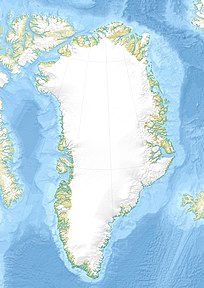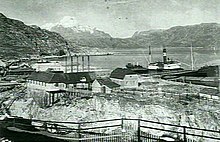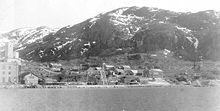Ivittuut
| Ivittuut (the one with many blades of grass) | ||
|---|---|---|
| Ivigtût | ||
| Ivittuut (2011) | ||
| Commune | Kommuneqarfik Sermersooq | |
| District | Ivittuut | |
| Geographical location | 61 ° 12 '23 " N , 48 ° 10' 18" W | |
|
|
||
| Residents | 0 |
|
| Time zone | UTC-3 | |
| particularities | Breakdown of cryolite | |
Ivittuut [ iˌviˈtːuːtˢʰ ] ( Ivigtût according to the old spelling ) is a deserted, fallen Greenlandic city in the Ivittuut district in the Sermersooq commune .
location
Ivittuut is located on the south bank of the Ilorput (Arsukfjord). A road connects Ivittuut with Kangilinnguit, 4.5 km northeast . The next permanently inhabited settlement is Arsuk, 15 km to the west .
history
Discovery of the cryolite
The people of Greenland had long known that there was cryolite in Ivittuut . They used the mineral as a weight for their fishing rods and as an extender for snuff . In 1795 Heinrich Christian Friedrich Schumacher reported for the first time about the Greenland deposits. In 1809 the deposits in Ivittuut were examined more closely by Carl Ludwig Giesecke . In 1823 Jöns Jakob Berzelius examined the cryolite more closely. For a long time, however, cryolite was considered worthless, while silver and tin were mined early in Ivittuut, which was found in small quantities alongside cryolite.
First years of mining in Ivittuut

It was not until 1852 that the young Danish chemist Julius Thomsen examined the Giesecke sample and discovered a method for producing alums and sodium carbonate from cryolite. In 1853 he received the royal Danish patent for the further processing of cryolite, which was valid for ten years. At the same time it was determined that only Den Kongelige Grønlandske Handel was allowed to mine the mineral. In 1850 the merchant Jacob Henrik Lundt, who had the sole right to mine in Greenland, first mined cryolite in Ivittuut together with the English engineer Joseph Walter Tayler. Inspector Hinrich Johannes Rink commissioned the Udsteds administrator of Arsuk with the dismantling, but no ship was found that could bring the cryolite to Denmark. However, because Thomsen could not start production within a year, the patent threatened to expire.
The gas works manager Georg Howitz joined forces with Thomsen and asked for an extension of the deadline. Cryolite could be brought to Denmark for the first time in 1854, but due to logistic problems no further cryolite reached Denmark in the following year. In January 1856, Thomsen and Howitz asked that, if necessary, they could mine the cryolite themselves and bring it home at significantly higher costs and taxes. This was only possible through the financing of the businessman Carl Frederik Tietgen . The government increased the pressure on the trade and suggested that Thomsen, Howitz and Tietgen should come to an agreement with the inspector themselves. Finally, Tietgen managed to take over the transport of the cryolite himself, and in the same year a first cargo of 103 tons of cryolite was brought to Denmark by ship.
Lundt and Tayler observed this with concern, as they were of the opinion that anything that was not cryolite should not be touched by Thomsen and Co., which was inevitable. In 1856 Thomsen and Howitz received the right to two years of further dismantling, which was extended from 1858 to 1863. In 1859, the processing of the already mined cryolite began in Copenhagen in the Øresund factory . Because Lundt and Tayler and the two brothers Regnar Westenholz and Anders Peder Westenholz continued to insist on their rights in Ivittuut and this was also approved by the government, the economic return was initially low. In 1864 the Kryolith-Mine- og Handelsselskabet joint-stock company was founded. The Øresund factory founded by Thomsen and Howitz was taken over by Vilhelm Jørgensen and Gustav Adolph Hagemann . The Danish government approved the mining of the cryolite under the joint stock company until 1884. The permit was then extended to 1904.
In 1894 they stopped making sodium carbonate from cryolite because cheaper methods had been discovered. However cryolite could also enamels of pots and kettles , as well as for the production of milk glass are used. They had also discovered how to make aluminum from cryolite. In the 1890s, over 100 ships annually left Ivittuut to export the cryolite to Denmark and the United States to Natrona, Pennsylvania . In 1904 the mining permit was extended to 1924 and in 1914 prematurely to 1940. The mine was an open pit that was 180 m long, 28 to 65 m wide and 50 m deep.
20th century
From 1911 Ivittuut belonged to the municipality of Arsuk. The presence of the Danes in Ivittuut and their meetings with the residents of Arsuk led to syphilis outbreaks in Arsuk, which became so problematic that Arsuk was one of the first places in Greenland to receive a hospital and the place was completely isolated from the rest of the country, one Avoid spreading the disease. Traffic was also severely restricted between Arsuk and Ivittuut.
The mining settlement of Ivittuut was even larger than some of the colonies in 1918 with a length of over 300 meters. At that time, only one European family of five and three Greenlanders with permanent residence lived in Ivittuut. Among them was the Danish controller and a Greenland cook. The inspector's apartment dates from 1863 and measured 132 m², was a wooden house with five rooms, a kitchen and two attic chambers. The cook lived in a 19 m² wooden house with two rooms, an outbuilding and a stable. In addition, there were a total of 65 buildings for mine workers and for supply, as a warehouse, etc. That made Ivittuut a city even then. In addition to the eight permanent residents, the rest of the population changed every six months. Altogether, Ivittuut was inhabited by around 120 people in summer and 60 people in winter. The miners were mostly young, untrained Danes from the countryside who had just done their military service.
After the expiry of the permit for the Kryolite Mine og Handelsselskab in 1940, the Kryolitselskabet Øresund took over the mining as a merger of the old stock company and the processing factory.
During the administrative reform in 1950, Ivittuut became a separate municipality, by far the smallest in the country. In 1987 the mining was stopped because the ore reserves were exhausted and cryolite could meanwhile be produced synthetically. 3.5 million tons (about 1.2 million m³) of cryolite had been mined in the 122 years, with 80,000 tons of ore being extracted in 1943 alone.
Traces of siderite , galena , silver , sphalerite , chalcopyrite , quartz , topaz and fluorite were also found in the cryolyte . Ivittuut is also the first place where, for example, Bøggildit , Bøgvadit , Jarlite , cryolithionite and Weberite were found .
With the end of the cryolite mining, the economic basis of Ivittuut also disappeared and the place was abandoned. In 2009 the area of the former municipality of Ivittuut was incorporated into the new Kommuneqarfik Sermersooq .
List of colonial employees until 1921
In Ivittuut, the following inspectors were in charge of the mining operations until 1921.
- 1864–1865: Jonathan Mathiesen
- 1865–1871: Harald Saxtorph
- 1871–1873: Jonathan Mathiesen
- 1873–1876: Morten Smith Schønheyder
- 1876–1878: Thorvald Vilhelm Christian Nørregaard
- 1878–1882: Ulrik Frederik Rosing
- 1882–1883: Baldwin Fernando Sørensen (interim)
- 1883–1884: Ulrik Frederik Rosing
- 1884–1886: Oscar Peter Cornelius Kock
- 1886-1892: Valdemar Møller
- 1892–1898: Carl Emil Basse
- 1898–1899: John Christian Gustav Baumann
- 1899–1902: Oluf Hastrup
- 1902–1903: Jacob Johan Jantzen
- 1903–1914: Axel Carl Emil Petersen
- 1914–1915: Poul Hermann Ibsen (interim)
- from 1915: Axel Carl Emil Petersen
Population development
About 40 people lived in Ivittuut in the last years of mining. Since the end of the cryolite mining, the place was almost unpopulated. From 2000 to 2012 people lived in Ivittuut again for a while, but the place has been completely deserted since 2013.

Web links
Individual evidence
- ↑ Map with all official place names confirmed by Oqaasileriffik , provided by Asiaq
- ↑ a b c d e f Ivittuut in Den Store Danske
- ^ A b Poul Peter Sveistrup: Kryoliten og staten in the Tidsskriftet Grønland (2/1956) (.pdf)
- ↑ a b c d Ole Bendixen : Beskrivelse af Distrikterne i Sydgrønland: Frederikshaab District. Danske Erhverv . In: Georg Carl Amdrup , Louis Bobé , Adolf Severin Jensen , Hans Peder Steensby (eds.): Grønland i tohundredeaaret for Hans Egedes landing (= Meddelelser om Grønland . Volume 60-61 ). tape 2 . C. A. Reitzel Boghandel, Copenhagen 1921, p. 343 ff . ( Digitized in the Internet Archive ).
- ↑ Jens Christian Madsen: Udsteder og bopladser i Grønland 1901-2000 . Atuagkat, 2009, ISBN 978-87-90133-76-4 , pp. 67 ff .
- ↑ Ole Bendixen : Beskrivelse af Distrikterne i Sydgrønland: Frederikshaab District. Bopladser i Frederikshaab district. Cryolite brother Ivigtût . In: Georg Carl Amdrup , Louis Bobé , Adolf Severin Jensen , Hans Peder Steensby (eds.): Grønland i tohundredeaaret for Hans Egedes landing (= Meddelelser om Grønland . Volume 60-61 ). tape 2 . C. A. Reitzel Boghandel, Copenhagen 1921, p. 368 f . ( Digitized in the Internet Archive ).
- ^ Hother Ostermann : Beskrivelse af Distrikterne i Sydgrønland: Frederikshaab district. History . In: Georg Carl Amdrup , Louis Bobé , Adolf Severin Jensen , Hans Peder Steensby (eds.): Grønland i tohundredeaaret for Hans Egedes landing (= Meddelelser om Grønland . Volume 60-61 ). tape 2 . C. A. Reitzel Boghandel, Copenhagen 1921, p. 372 f . ( Digitized in the Internet Archive ).
- ↑ Population of Ivittuut 1977–2018 at bank.stat.gl





